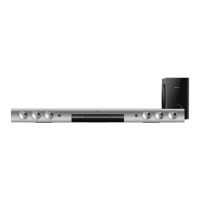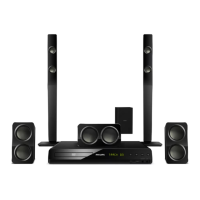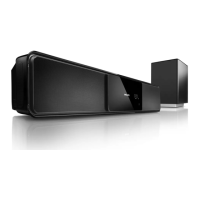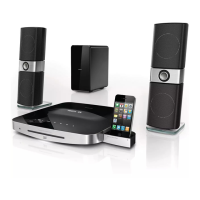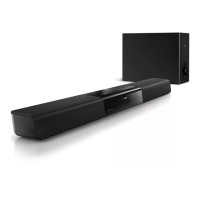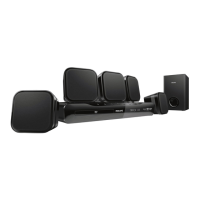Do you have a question about the Philips HTB5151K/51 and is the answer not in the manual?
Accesses and navigates the built-in user manual for assistance.
General safety guidelines to prevent hazards during product use.
Precautions against electric shock, short circuits, fire, and overheating.
Safety measures to prevent injury, damage, and contamination from product use.
Warnings about battery ingestion and child safety.
Guidelines for product maintenance, cleaning, and responsible disposal.
Health advisory for 3D viewing for sensitive individuals.
Overview of the functions of the remote control buttons.
Explains functions of common remote control buttons like OK, Back, Options.
Details of AC MAINS, OPTICAL IN, and USB ports on the rear left.
Details of rear right ports and subwoofer connection.
Recommended placement for the subwoofer for optimal performance.
Connecting your TV using HDMI (ARC and Standard) for video and audio.
Connecting your TV using composite video for basic quality video.
Connecting digital devices such as consoles or set-top boxes via HDMI.
Playing audio from TV or other external devices through the home theater.
Connecting audio via digital optical, digital coaxial, or analog cables.
Configuring EasyLink for simplified control of connected HDMI devices.
Enabling and using EasyLink features for device control.
Setting up audio output and connecting to a home network.
Instructions for setting up wired Ethernet and wireless Wi-Fi network connections.
Naming the home theater and navigating the main menu for system features.
Guide to playing discs, using playback buttons, and synchronizing audio/video.
Instructions and requirements for playing Blu-ray 3D discs.
Using Bonus View and BD-Live features for enhanced Blu-ray content.
Playing data files and selecting subtitle languages for video.
Registering for DivX VOD and using USB storage devices for media.
Advanced playback options for media files, including audio, video, and picture settings.
Creating musical slideshows and operating the FM radio.
Connecting MP3 players and controlling the system via smartphone app.
Streaming media content and accessing Smart TV features.
Navigating Smart TV, using USB input, and renting online videos.
Accessing PC files via DLNA and listening to internet radio.
Configuring media server software for enabling file sharing.
Adjusting language preferences and picture/video display settings.
Configuring audio, parental controls, and display panel settings.
Adjusting energy saving modes and speaker audio processing.
Resetting the home theater to its factory default settings.
Verifying the current software version installed on the home theater.
Instructions for updating software via USB flash drive or internet connection.
Updating the built-in help content on the home theater.
Details supported file formats, region codes, and audio formats.
Lists supported media disc types and file formats.
Lists supported video file formats, resolutions, and codecs.
Details amplifier power output, frequency response, and speaker system specifications.
Solutions for issues with the main unit controls and picture display.
Troubleshooting no picture via HDMI and HD disc playback failures.
Solutions for sound issues, no sound, distorted audio, and sync problems.
Troubleshooting playback failures, file format compatibility, and subtitle display.
Troubleshooting USB read errors, EasyLink, and BD-Live access.
Resolving 3D mode issues, black screens, and online download problems.
Troubleshooting general network and wireless connection issues.
Legal notices regarding copyright, open source software, and RMVB user agreement.
Product compliance statements and list of trademarks.
| Speaker Configuration | 5.1 |
|---|---|
| HDMI Inputs | 1 |
| Bluetooth | Yes |
| USB Playback | Yes |
| DVD player included | Yes |
| HDMI ports quantity | 1 |
| Audio Return Channel (ARC) | Yes |
| Near Field Communication (NFC) | No |
| HDMI Output | 1 |
| Wall Mountable | Yes |
| Supported disc types | CD, DVD |
| Type | Home Cinema |
| Sound Enhancement | Dolby Digital |
